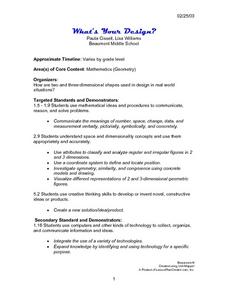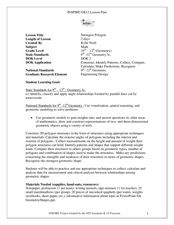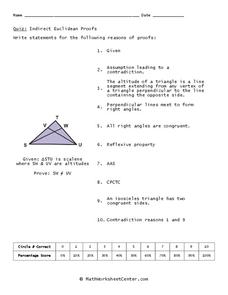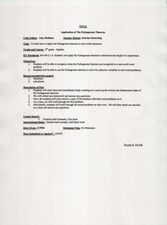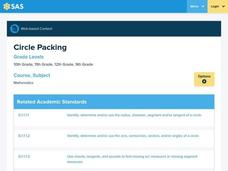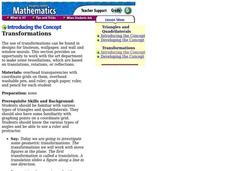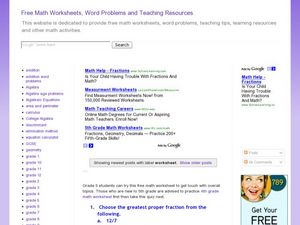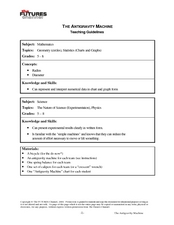Curated OER
What's Your Design?
Sixth grade middle schoolers: design a stained glass window, submitting their initial plan detailing the measurements of all lines and angles. Seventh grade students: create a scale drawing of their own geometric family of four members.
Curated OER
Triangles
For this triangles worksheet, students identify 3 triangles by the length of their sides and 3 triangles according to their internal angles.
Curated OER
Surface Area with Polydrons
Students explore measurements by analyzing geometric shapes. In this surface area lesson, students identify the terms volume, weight, perimeter and area in order to find the requested measurements of specific polygons. Students utilize...
Curated OER
Reflections
Fifth graders create a reflection of a poygon using a Mira. They discover that a line connecting a vertiex of a polygon and the corresponding vertex of its reflection is perpendicular to the line of reflection. Students create a glide...
Curated OER
Strongest Polygon
Students define and identify shapes by name. In this geometry lesson, students construct, identify and compare polygons based on the number of sides. They classify each shape based on their angle sum theorem.
Curated OER
Math is Beautiful
Students explore how geometry is used on the composition of artworks by artists from different cultures. This instructional activity is equally suited for a Math or Art classroom at the late-elementary or early-middle school level.
Curated OER
Indirect Euclidean Proofs
In this Euclidean proofs activity, 10th graders solve 10 different problems that include completing indirect Euclidean proofs. First, they write a statement for each of the reasons listed on the sheet of proofs. Then, students solve the...
Curated OER
Symmetry in Kaleidoscope Designs
Students define reflection, rotation and symmetry. In this symmetry lesson, students move the graph around the coordinate plane and identify the line of symmetry. They identify the different designs of a kaleidoscope.
Curated OER
Application of the Pythagorean Theorem
Students find the length of the hypotenuse using the Pythagorean Theorem. In this geometry lesson, students solve for the different parts of a right triangle. They work the first problem with-the teacher then work on their own.
Curated OER
Pythagorean Theorem
Students solve problems using the Pythagorean Theorem. In this geometry lesson, students identify the sides and angles of a right triangle. They find the different trigonometric ratios and solve using sine, cosine and tangent.
Curated OER
Let's Explore the World of Triangles and Quadrilaterals!
Second graders explore the features of triangles and quadrilaterals. In this instructional activity on triangles and quadrilaterals, 2nd graders rotate with their group to five different activities all exploring a different aspect of...
Curated OER
Introduction to Fractals: Infinity, Self-Similarity and Recursion
Students think about several of the concepts from fractals, including recursion and self similarity. They use mathematical concepts of line segments, perimeter, area and infinity are used, and skill at pattern recognition is practiced.
Curated OER
Circle Packing
Students identify different parts and properties of circles. For this geometry lesson, students identify the radius, diameter, semicircle and inscribed angle of a circle. They identify the tangent lines to a circle.
Pennsylvania Department of Education
Rotational Symmetry of Polygons and Other Figures
Students explore geometry by participating in a shape rotation experiment. In this symmetry lesson, students identify the term symmetry and a list of other geometry vocabulary. Students analyze shapes as they are turned 90 degrees and...
Curated OER
Platonic Solids
Students identify different types of polygons. In this geometry lesson, students differentiate between convex and regular shapes. they identify the names of two and three-dimensional objects.
Curated OER
Transformations
Students draw on graph paper. In this geometry lesson, students review types of triangles and quadrilaterals. Students investigate geometric transformations, including translation, rotation and reflection. Students practice each...
Curated OER
Math All Around Us!
Learners find math concepts in every day items. In this math concept lesson, students take ten photographs of things they find interesting. They analyze the photographs to find hidden math concepts such as counting, lines, angles,...
Curated OER
4th Grade Math Worksheet
In this 4th grade math review worksheet, students respond to 60 multiple choice questions that review of fractions, decimals, geometry, number sense, and computation.
Curated OER
Midpoint of a Segment
Learners revisit midpoint and segments by graphing on the TI or computer. This activity can be done with pencil and paper, but is more interactive if it is done on a TI-navigator.
Curated OER
Right Triangles
In this right triangles worksheet, 10th graders solve and complete 12 various types of problems. First, they solve for x given each of the right triangles shown. Then, students determine the length of the shorter diagonal given the...
Curated OER
Area of Polygons
In this area of polygons worksheet, 10th graders solve and complete 12 various types of problems. First, they find the area of a given square. Then, students find the length of an original square as illustrated. They also write an...
Curated OER
Measurement Activity
For this geometry worksheet, students use a ruler and a protractor to measure the lengths of the line segments and size of the angles that make up a drawing of a Christmas tree. The one page worksheet has one problem. Answers...
Curated OER
The Anti-Gravity Machine
Students examine physics by completing a bicycle experiment in class. In this gravity lesson plan, students measure the characteristics of different bicycles and compare their different race times. Students utilize a shoebox,...
Curated OER
Mathematics Within: Shape, Space & Measurement
Students experiment and analyze triangulation to assess degrees of combined angles, predict polygons that tessellate as well as extending of shapes to create tessellations. They explore the concept of why some polygons tessellate when...


